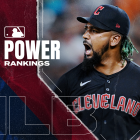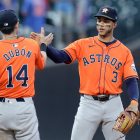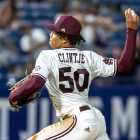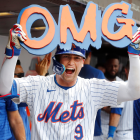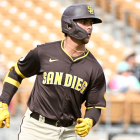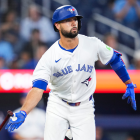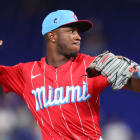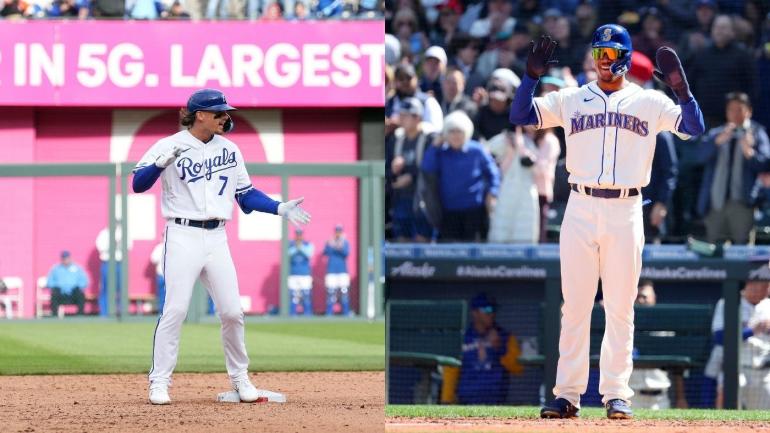
The Royals and the Mariners will begin a three-game series Friday night in Seattle that will feature two of the most promising youngsters in the sport: Kansas City third baseman Bobby Witt Jr. and Seattle outfielder Julio Rodríguez. Those two entered the spring ranked as the second and third best prospects in the minors, trailing only Baltimore Orioles catching prospect Adley Rutschman, who should debut later this season.
Neither Witt nor Rodríguez has set the world on fire during their initial two weeks in the majors. Witt entered Thursday with an 11 OPS+, while Rodríguez was faring slightly better, with his OPS+ sitting at 28. Those early woes aside, CBS Sports decided to highlight both players heading into this weekend. Consider this both a review of their seasons to date and a preview of the better days that lie ahead.
We'll start with a positive: Witt looks the part of a high-quality defensive third baseman. He primarily played shortstop dating back to his amateur days, recording just 18 appearances at the hot corner as a minor leaguer. He's already more than halfway to that number in the majors, but you wouldn't know it based on his play.
There's a customary set of plays you'd expect a good third baseman to be able to make, similar to a wide receiver's route tree. This entails charging in on the ball; showing quick reflexes to your left and right; starting around-the-horn double plays; and, for now, even displaying a feel for playing at shortstop in overshift situations. Witt has had no problem with any of the above. He has more than enough arm strength for the left side, and he's shown off the requisite agility, footwork, and body control on plays that have required him to range in any direction. Admire the tape:
Witt hasn't authored as many highlights at the plate. He hasn't been shy about trying to, though, swinging at more than half the pitches he's seen and expanding the zone more often than he should. The book on him clearly includes the command to throw him breakers. More than 40 percent of the pitches he's seen have been classified as a slider or curve, giving him the 17th highest rate among 177 qualified batters.
We will note that there have been moments, albeit rare so far, where Witt's star potential is apparent.
You've probably seen Witt's double on Opening Day; you likely did not see the one that came a few days later. In both cases, he showed off his hand speed by triggering his swing late, and the adjustability of his swing by yanking pitches that were outside of the zone to Kauffman Stadium's spacy outfield. (Of course, swinging outside the zone is part of his problem so far, but we're trying to focus on some good stuff here.)
Witt has also shown off his foot speed on several occasions, including when he inside-outed a triple down the right-field line, and when he nearly beat out a routine grounder to second base.
The warp and woof of being a successful big-league player is learning how to adjust and then how to adjust again once pitchers alter their game plans. It's a never-ending dance. Witt is learning the steps the hard way to begin his big-league career, but it's too early for serious concern. He has the physical tools to start bludgeoning balls, as well as the track record to indicate he's up for the task of adapting as needed.
There are believed to be only seven basic plots in storytelling, so it shouldn't come as a surprise that Witt and Rodríguez's tales share a lot in common.
To wit, they're both receiving a steady heaping of breaking balls. Rodríguez has faced a higher percentage of breaking balls (54 percent) than any other qualified hitter in the majors. Only one other individual in the majors, Witt's teammate Hunter Dozier as fate would have it, has seen as many as 50 percent breakers.
Rodríguez likes to swing the bat, and that, plus the breaking ball diet, has resulted in a lot of chases and a lot of whiffs. (His 41.9 percent K rate has also been juiced by some questionable called strike threes.) The key difference between Rodríguez's offensive output and Witt's to date has been that Rodríguez has made more hard contact.
Rodríguez entered Thursday with more than 57 percent of his batted balls recording an exit velocity of 95 mph or better. The catch is that his average launch angle on those batted balls is -4 degrees. Just one qualified batter has a lower launch angle than that: Tampa Bay's Randy Arozarena. Four of Rodríguez's five hardest-hit balls this season have had a negative launch angle, with three checking in worse than -10 degrees. For those wondering what a -21-degree launch angle looks like:
Hitting the ball hard is good, but hitting into the earth with this frequency has limited Rodríguez's output. He's recorded a single extra-base hit so far, and that was on the rare occasion where he managed to hit a liner. The rule of thumb for most evaluators who have spoken to CBS Sports on the matter is that they believe it's easier to fix a launch angle than teach a batter how to hit the ball hard. Rodríguez should be able to adjust at some point, and when he does his numbers are going to jump in a hurry.
If there is a plus side to Rodríguez's grounder-heavy ways, it's that it's enabled him to show off his wheels. He's faster than you might expect from someone whose scouting report has often mentioned he fits the prototypical right-field profile. Heck, he's even swiped four bases on four tries, with the home team's broadcast's rail camera allowing for cool visuals like this one, showing how easily he stole second base:
Rodríguez's speed and the Mariners' roster complexion has led them to playing him in center field. He was primarily a right fielder throughout the minors, and evaluators believe he'll return there based on his physical traits and their looks at him so far.
It's not that Rodríguez is whiffing on catchable balls left or right in a cartoonish manner. There is, nevertheless, an unease to a lot of his fielding opportunities, even when he completes the transaction. He also seems to get caught in-between too frequently, as if he's still becoming accustomed to the angles that come with playing in center. That's all understandable; again, he's new to the position, and it's not one he should necessarily be playing for long. But it is what it is at this point.
Anyway, you can see the outlines of Rodríguez's potential star form if you look closely. His ability to impact the baseball is going to make him a lot of money once he adjusts his approach and optimizes his angle, and if nothing else, the reps he's given in center field this summer will enhance his versatility even after he slides back to right.










